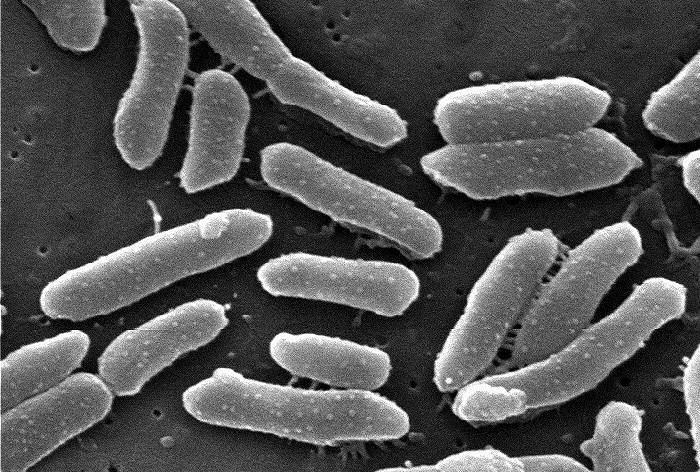Providencia: Difference between revisions
Jump to navigation
Jump to search
No edit summary |
|||
| Line 22: | Line 22: | ||
__NOTOC__ | __NOTOC__ | ||
{{CMG}} | {{CMG}} | ||
==Overview== | ==Overview== | ||
Providencia is a [[Gram negative]], [[motile]] [[bacterium]] of the family [[Enterobacteriaceae]]. Some strains (''[[Providencia stuartii|P. stuartii]]'', for example) are opportunistic [[pathogen]]s in humans and can cause [[urinary tract infection]]s, particularly in patients with long-term indwelling [[Foley catheter|urinary catheters]] or extensive severe [[Burn (injury)|burns]]. Other strains (for example ''[[Providencia burhodogranariea|P. burhodogranariea]]'' and ''[[Providencia sneebia|P. sneebia]]'') are found in the [[haemolymph]] of ''[[Drosophila melanogaster]]'' fruit flies. | Providencia is a [[Gram negative]], [[motile]] [[bacterium]] of the family [[Enterobacteriaceae]]. Some strains (''[[Providencia stuartii|P. stuartii]]'', for example) are opportunistic [[pathogen]]s in humans and can cause [[urinary tract infection]]s, particularly in patients with long-term indwelling [[Foley catheter|urinary catheters]] or extensive severe [[Burn (injury)|burns]]. Other strains (for example ''[[Providencia burhodogranariea|P. burhodogranariea]]'' and ''[[Providencia sneebia|P. sneebia]]'') are found in the [[haemolymph]] of ''[[Drosophila melanogaster]]'' fruit flies. | ||
Some strains are sensitive to [[ampicillin]]. | Some strains are sensitive to [[ampicillin]]. | ||
===Antimicrobial regimen=== | ===Antimicrobial regimen=== | ||
| Line 43: | Line 40: | ||
:::* Note (3): Duration for acute prostatitis (2 weeks), shorter than chronic prostatitis (4-6 weeks) | :::* Note (3): Duration for acute prostatitis (2 weeks), shorter than chronic prostatitis (4-6 weeks) | ||
:::* Alternative regimen: [[TMP-SMX]] DS PO q12h for 10-14 days or [[TMP]] 5-10 mg/kg/day IV q6h | :::* Alternative regimen: [[TMP-SMX]] DS PO q12h for 10-14 days or [[TMP]] 5-10 mg/kg/day IV q6h | ||
==Gallery== | ==Gallery== | ||
<gallery> | <gallery> | ||
Image: Enterobacteria42.jpeg| Providencia alcalifaciens bacteria cultured on a blood agar plate (BAP). <SMALL><SMALL>''[http://phil.cdc.gov/phil/home.asp From Public Health Image Library (PHIL).] ''<ref name=PHIL> {{Cite web | title = Public Health Image Library (PHIL) | url = http://phil.cdc.gov/phil/home.asp}}</ref></SMALL></SMALL> | Image: Enterobacteria42.jpeg| Providencia alcalifaciens bacteria cultured on a blood agar plate (BAP). <SMALL><SMALL>''[http://phil.cdc.gov/phil/home.asp From Public Health Image Library (PHIL).] ''<ref name=PHIL> {{Cite web | title = Public Health Image Library (PHIL) | url = http://phil.cdc.gov/phil/home.asp}}</ref></SMALL></SMALL> | ||
</gallery> | </gallery> | ||
| Line 57: | Line 51: | ||
[[Category:Enterobacteria]] | [[Category:Enterobacteria]] | ||
[[Category: Infectious Disease Project]] | |||
Revision as of 15:43, 8 August 2015
| style="background:#Template:Taxobox colour;"|Providencia | ||||||||||||
|---|---|---|---|---|---|---|---|---|---|---|---|---|
 Providencia alcalifaciens
| ||||||||||||
| style="background:#Template:Taxobox colour;" | Scientific classification | ||||||||||||
| ||||||||||||
| Species | ||||||||||||
|
P. stuartii |
Editor-In-Chief: C. Michael Gibson, M.S., M.D. [1]
Overview
Providencia is a Gram negative, motile bacterium of the family Enterobacteriaceae. Some strains (P. stuartii, for example) are opportunistic pathogens in humans and can cause urinary tract infections, particularly in patients with long-term indwelling urinary catheters or extensive severe burns. Other strains (for example P. burhodogranariea and P. sneebia) are found in the haemolymph of Drosophila melanogaster fruit flies. Some strains are sensitive to ampicillin.
Antimicrobial regimen
- Providencia[1]
- 1. Complicated uti/bacteremia/acute prostatitis
- Preferred regimen (1): Ciprofloxacin 500-750 mg PO q12h or 400 mg IV q8-12h
- Preferred regimen (2): Levofloxacin 500 mg IV/PO q24h
- Preferred regimen (3): Piperacillin-Tazobactam 3.375 mg IV q6h
- Preferred regimen (4): Ceftriaxone 1-2 g IV q24h (donot use if ESBL suspected or critically ill)
- Preferred regimen (5): Meropenem 1 g IV q8h (consider if critically ill or ESBL suspected)
- Preferred regimen (6): Amikacin 7.5 mg/kg IV q12h
- Preferred regimen (7): Gentamicin
- Preferred regimen (8): Tobramycin acceptable if susceptible but many species are resistant
- Note (1): Duration of treatment for (UTI) is 7 days common or 3-5 days after defervescence or control/elimination of complicating factors (e.g.,removal of foreign material catheter).
- Note (2): Duration of treatment for (bacteremia) is 10-14 days or 3-5 days after defervescence or control/elimination of complicating factors
- Note (3): Duration for acute prostatitis (2 weeks), shorter than chronic prostatitis (4-6 weeks)
- Alternative regimen: TMP-SMX DS PO q12h for 10-14 days or TMP 5-10 mg/kg/day IV q6h
Gallery
-
Providencia alcalifaciens bacteria cultured on a blood agar plate (BAP). From Public Health Image Library (PHIL). [2]
References
- Ryan KJ; Ray CG (editors) (2004). Sherris Medical Microbiology (4th ed. ed.). McGraw Hill. ISBN 0-8385-8529-9.
- ↑ Bartlett, John (2012). Johns Hopkins ABX guide : diagnosis and treatment of infectious diseases. Burlington, MA: Jones and Bartlett Learning. ISBN 978-1449625580.
- ↑ "Public Health Image Library (PHIL)".
![Providencia alcalifaciens bacteria cultured on a blood agar plate (BAP). From Public Health Image Library (PHIL). [2]](/images/e/ef/Enterobacteria42.jpeg)